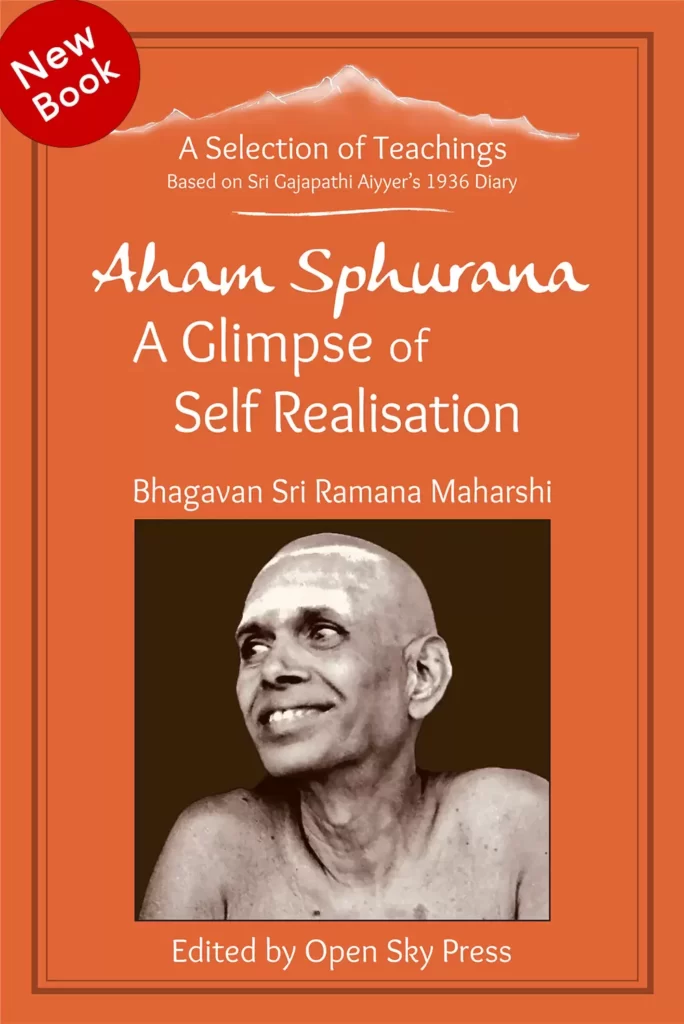
Aham Sphurana
A Glimpse of Self Realisation
New Book about Sri Ramana Maharshi

Available Worldwide
On www.openskypress.com and Amazon:

“In my opinion, Aham Sphurana, a Glimpse of Self Realisation, will become a Treasure Trove of Wisdom to the Seekers of Truth in general, and particularly to the devotees of Bhagavan.”
Swami Hamsananda – Athithi Ashram, Tiruvannamalai
Ramana Maharshi on Renunciation
Q.: How does viveka [discernment] differ from vairagya [renunciation]?
B.: Mere intellectual discernment of the real from the unreal is not of any great use. The unreal must be totally shunned. That is to say, the mind must be divested of any inclination to pursue it. One’s vasanas [tendencies of mind] must be incinerated to the point of complete annihilation in the fire of vairagya; otherwise rebirth cannot be successfully avoided. Viveka may stop with intellectualisation and mental contemplation of the truth. But without vairagya Jnana cannot be achieved.
Q.: Summayirutthal [natural being] or the investigation “Who am I?” Which is the quickest and most efficacious route leading to realisation of the Self?
B.: As and when thoughts arise, or whenever you feel, languorous, ask yourself “Who am I?” so that you can return to the state of summayirutthal; otherwise remain as you are, that is, summayiru. Summayirutthal is the goal of all our effort to remain without any effort.
When summayirutthal has become permanent and natural, the resultant state of mind — in which there is effortlessly maintained, thought-free, and languor-free Subjective Consciousness—matures automatically into Jnana.
What does it mean to say that one is in the state of summayirutthal? When the mind is completely submerged in the Shining of the Heart, one is said to be in the state of summayirutthal. When it is no longer possible for the mind to emerge from or leave the Heart, the person is said to have attained Self-Realisation.
When the jiva’s [human] latent vishayavasanas [tendencies with objects] and poorvasamskaras [habits] have not yet been totally destroyed, Realisation is not possible. In the case of such jivas, when the mind submerges itself in the Shining of the Heart it is invariably bound to eventually forsake this position;; such temporary or reversible submergence is known as ahamsphoorti or vrittijnana.
Submergence, never to rise again, is Emancipation or Sahajajnana [spontaneous Self-realisation]. Sahajajnana cannot exist side-by-side with vasanas. The state of summayirutthal is vouchsafed in both vrittijnana and Sahajajnana. What then is the difference? In both, the mind is sucked in so as to result in total submergence in the Heart, but in vrittijnana the mind’s distinctive identity is kept unimpaired and not harmed. Whereas in Sahajajnana the mind is totally ruined and destroyed. For this reason, in the case of one whose vasanas still lie dormant in the cover of the Heart, after some time the experience ofvrittijnana is lost and one’s mind starts wandering and meandering again; whereas in the case of one who has altogether relinquished all his vasanas, vrittijnana goes on to mature into Sahajajnana.
The investigation “Who am I?” is a tool with which to retire into the state of summayirutthal. To shake off thoughts and keep torpidity away: these are essential if one wants to get rid of the mind. For this purpose vichara is suggested. Vichara is a gentle, safe, and effective tool for coaxing the mind back into its nativistic state of summayirutthal. Summayirutthal is the way to Jnana. Vichara is the way to summayirutthal.
Q.: What is swapnasakshatkara? I heard Bhagavan talking about it last week but could not understand what he was saying.
B.: Some deceive both themselves and others into believing that they are Jnanis. They falsely imagine themselves to be Jnanis — so much so that they themselves honestly believe that they are Jnanis. The actual Jnani can never say, “I am a Jnani.” For what is left in him to make that claim? To believe yourself to be this or that implies the continued existence of the “you” in whom that belief is harboured. Those who think arrogantly, “I am Brahman, and therefore am entitled to do precisely as I please,” have already wandered far, far away from the path of illumination. A mind that has remained cosseted in the darkness of self-conceit for a long time will actively resist attempts to bring it to the path leading to redemption. Have you not heard of the proverb: Somebody who is pretending to be asleep can never be woken up.
Q.: Is it wrong to believe that I am the Self?
B.: Is it the Self who believes Himself to be the Self? If not, who is the impostor or doppelgänger who, not being the Self, falsely pretends to be the Self or imagines himself to be the Self or believes that he is the Self? The Self is the Impersonal Absolute. There is no question of Him believing or disbelieving in anything. So, the Self never does any believing or imagining or asserting. For this reason, that which believes in anything cannot be the Self.
You say that you believe that you are the Self. This proves that the “you” who is engaged in the act of believing is not the Self. So who are you who believe yourself falsely to be the Self? Ahambrahmasmi [higher Self] does not mean that the ego is the Self. It only means that so far as the Jnani is concerned, the Self is the same as Parabrahman. The mahavakyas can practically hold good only after the ego-self has been fully removed. The meaning of the mahavakyas could only ever be “potential-truth” as far as the ajnani is concerned.
Ahambrahmasmi means that the true “I” is Parabrahman and nothing but Parabrahman. The mahavakyas must be understood in the correct spirit. Their intention is not for the ego to claim the stature of Parabrahman, but to remind man that there is a Self available for experience beyond the petty ego, and that this is the same as Parabrahman or Absolute Reality.
The ultimate goal of all the srutis [sacred books] is to facilitate the aspirant to trace his mind back into its source, the Heart. What is the aim of life? Mukthi. What is Mukthi? It is to irrevocably merge the mind in the Heart, irretrievably leaving it there to perish once and for all.
Q.: I am swayed frequently by the many tempting distractions this world has to offer.
B.: The world is nothing but information manufactured — and not sensed or discerned — by one’s sensory perceptiveness’s. Sensory information does not have an external origin. The cosmos is projected by and from your own mind only.
Q.: What is Bhagavan’s motto that he likes to give to spiritual aspirants?
The master remained silent but somebody shouted from the back of the Hall, “I think it is ‘Stop smoking; Keep walking.’ Isn’t that so, Bhagawan?’.
The master laughed shortly but did not otherwise respond.
Q.: Is that so?
B.: Tobacco is an insidious poison. It is better to give it up and make do without it.
Q.: What about walking?
B.: Yes. Keep walking around this Hill. It brings about all sorts of benefits.
Q.: I have enough worldly wealth and have no craving for more. Please tell me whether going around the Hill will bring me peace of mind
B.: Yes.
Q.: In caricatures of Lord Shiva we see that he has been depicted as being an anthropomorphic person with three eyes, all of which happen to be in the opened position. Does it mean that if man also opens his third eye, he would merge into or become one with, or the same as, Lord Shiva Himself?
B.: Yes.
Q.: The third eye is the ajna-chakra. Am I correct in saying so?
B.: The third eye is that source which beams that light which illumines the other two eyes and facilitates them to see. Light from the Heart is caught or reflected by one’s vishayavasanas and poorvasamskaras, giving rise to the phenomenon of reflection that is referred to as “mind”.
The air that flows through a flute is the same, but the instrument produces many mutually distinguishable sounds based on which holes are covered and which left uncovered. Likewise, such phenomenon of reflection as just mentioned is capable of producing multiple personalities depending upon the nature of those impurities that catch the light of mahat [pure awareness] and so cause reflection.
Mahat itself is pure awareness and nothing but that; its source is the self-resplendent Heart. If one were to suppose that the Self could be compared to the sun, mahat might be compared to a ray of light proceeding from there. The third eye is the infinitesimally minuscule point at which the light of mahat is caught by the individual’s mental traits of personality, leading to emergence of that which is known by us as “mind”.
While it is true that this point has no spatial or temporal manifestation on the relativistic plane, it draws attention to itself when the mind is in the state of sphurana [realisation], and one perceives it then to be on the right-hand side of the chest, two digits to the right of the median. However, all this is true only from one’s present vantage point. When mind is dissolved and washed away in the all-consuming fire of Jnana, the body is also irretrievably lost; then the question of the third eye’s location cannot possibly arise.
Q.: How to open this third eye?
B.: Clearing consciousness of all its contents and making it shine by itself and of itself is tantamount to opening of one’s third eye.
Q.: How is that to be done?
B.: By eradicating all the mind’s vrittis. Other vrittis are only modifications of the ahamvritti. If the ahamvritti is killed, our work is finished.
Q.: How to kill the ahamvritti?
B.: By means of it discovering [not intellectually or conceptually, but actually] that itself, the discoverer, has no existence.
Q.: Practically, what am I to do?
B.: Investigate, “Who am I?”
Q.: What is the way leading to Emancipation?
B.: Total, permanent, effortless, and volitionless submergence of mind in the Shining of the Heart.
Q.: What is Emancipation?
B.: From the present standpoint, one may say that it is deliverance from samsara. But the fact is that there is no such thing as bondage or liberation. What is, is and continues always to be. That which is not never could be. The truth was beautifully summarised by Sri Krishna when he said “nasathovidhyathaebhavo nabhavovidhyathaesataha”.
Q.: But can it be denied that samsara or ajnana appears real to those who are experiencing it?
B.: First and foremost, ask yourself who the experiencer is. After finding out the answer to this question, let us raise other questions if need be.
Edited by John David Oct 2021







